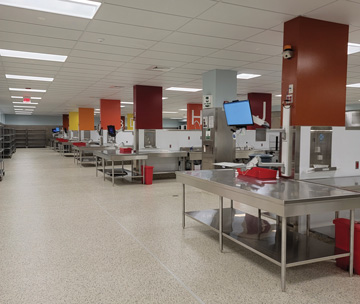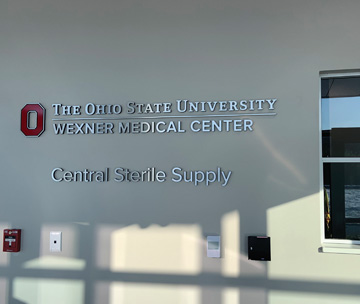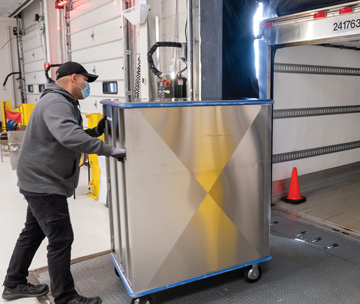- Home
- The Magazine
- Article
Point-Counterpoint: Offsite vs. In-House Sterile Processing
By: Adam Taylor | Managing Editor
Published: 4/1/2024
Experts debate the pros and cons of each model.
We recently spoke with two experts: An administrator of an ambulatory surgery center that contracted with a third-party, offsite sterile processing facility after his ASC started a total joints service line, and a sterile processing clinical educator. The administrator says the model has been crucial to his center’s success, while the educator cautions that the offsite concept isn’t the best option for many facilities. Here’s what they said:
POINT: Shipping instruments offsite reduces tray backlogs and case delays, positions facilities for volume growth, increases cleaning compliance with devices’ instructions for use and keeps OR teams happier because the trays are assembled with fewer dirty or missing instruments.
Jesse Hixson, MSN, RN, CNOR
Administrator at Allegheny Health Network’s Monroeville (Pa.) Surgery Center
Our multispecialty ASC has four ORs and three procedure rooms. Space is tight, and when it comes to our square footage for sterile processing functions, we’re essentially landlocked. So our only option when we wanted to start a total joints service line was to contract with an offsite, third-party facility. We’ve been using them for almost two years and would not have been able to start our total joints program with the sterilization equipment we have in-house.
The facility is about an hour away from ours, and we use it exclusively for the loaner sets the vendors provide for our joint replacement cases. The vendors drop the trays off at the sterile processing site where they wash, sterilize and wrap them. Vendors deliver trays to us 48 hours in advance of a case. When the case is complete, we pre-wash the instruments, reassemble the tray, bag everything so there’s no leakage in their trucks and the company picks them back up for reprocessing.
The arrangement has been seamless to date. There have been zero missing instruments and zero holes in the blue wrap. The only infection we’ve had since we started doing total joints was traced back to a patient issue.
Our washers and sterilizers couldn’t have handled the volume of the total joints sets. It would have cost $500,000 to $600,000 to upgrade our SPD to handle it. The money we saved allowed us to reallocate the finite amount of capital dollars we had for the total joints expansion project, and we used some of the money we saved to completely upgrade our fleet of power tools.
In theory, you’re at the mercy of the third party to come through for you, but we haven’t had any issues yet. There is a lot of trust involved, however. There are tight windows involved when vendors deliver trays less than 48 hours before we’re scheduled to use them. That’s why we got physician- and ownership support to insist the vendors provide extra trays for use to have on hand in the event the primary tray can’t be delivered. That hasn’t happened yet, but we always have backup sets. We’ve been fortunate to not have any issues with the trays arriving because of bad weather — lucky to have had two mild winters in the Pittsburgh area.
A member of leadership and our infection control nurse visit the site twice a year, and I have a monthly phone call to make sure neither party is having any issues with the other.
We would not have been able to start our total joints program with the sterilization equipment we have in-house.
Jesse Hixson, MSN, RN, CNOR
Currently, the offsite facility we use is at their capacity, but has talked about expanding. If they do, that would be a factor in whether we introduce a spine service line here, which I’d do in a heartbeat if we can make it happen.
As with any new process, the change was difficult for us in the beginning. We had to prove to the doctors and nursing staff that we were on top of the new system and addressed any issues as soon as they arose. I think the fact that we communicated well with them from the start about their concerns went a long way to put them at ease.

Penn Medicine. The 110,000-square-foot sterile processing behemoth, known as the Interventional Support Center, opened in March 2021. Officials realized during the design for the expansion of the Hospital of the University of Pennsylvania in Philadelphia that more space was needed for its sterile processing functions. The SPD activities were already suboptimal, taking place on two floors. Rather than dedicate an entire floor of the new building that could be better used for clinical work, the hospital opted for an offsite model. The facility opened during a snowstorm without a hitch. The ample space allowed for a sound one-way forward-flow approach so instruments never enter a “dirty” section while making their way to the next “clean” area of the reprocessing cycle. The facility also serves as a major prep site for much of the Penn Medicine’s soft goods such as gowns, towels, filters, and gauze.

Ohio State University Wexner Medical Center. This $46.3 million facility opened in February 2021 and was the first of its kind in the state. The 62,000-square-foot space has the capacity to serve multiple hospitals and same-day surgery centers and process instruments for 48,000 patients per year. Based on the concept that surgery is the moneymaker for health systems and the fact that central sterile is the lifeblood of surgical operations, the facility also prepares and packs other supplies for cases and features an onsite service that repairs, refurbishes and maintains instrumentation as needed in addition to reprocessing it daily. The space includes administrative offices, conference rooms and staff changing areas as well. Standardizing as many instrument sets as possible during the design phase of the facility helps maximize its efficiency. Transport trucks arrive every four hours from various surgical facilities within the health system.

Northwell Health. This massive New York health system was an early adopter to the offsite SPD concept, opening an $80 million reprocessing center on Long Island opened in 2018 at the site of a former popcorn factory. The facility serves multiple hospitals and outpatient surgery centers by processing instruments from up to 300 cases each day. Workers pick up instruments from Northwell facilities as late as 11 and deliveries begin at 4 a.m. Northwell officials report the reprocessing equipment never stops humming and the trucks never stop rolling. The facility includes an elaborate automated carousel storage system where technicians get instruments to replenish surgical trays for the next day’s cases.
—Adam Taylor
COUNTERPOINT: Offsite sterile processing has its place, but brings with it very real challenges, including concerns about transporting delicate instruments on a daily basis, compliance with federal transport regulations and sweating whether the sets you need will arrive on time. It also makes positive relationships between OR teams and CPD technicians more difficult.
Casey Czarnowski, CRCST, CSPDT, CIS, CER
Sterile processing consultant and clinical educator based in Rochester, Minn.
Offsite processing facilities can succeed, but present significant obstacles to success and are certainly not without risk. This biggest one is making sure federal Department of Transportation regulations are followed. Facilities need to be very aware of the rules surrounding the transport of potentially infectious material — the soiled surgical instruments leaving their facilities — and the transport of sterile material — the instrumentation that comes back to you wrapped, containerized or in pouches.
The directives are very specific when it comes to times, temperature, humidity levels and labeling for transporting these items. The science on this isn’t perfect, but some studies surrounding the effect of heat and humidity on wrapped instruments suggest that their sterility could be compromised by high temperatures. Because the jury is out on this issue, facilities must be very careful about the environments to which they expose the surgical instrumentation they use on their patients. Of course, they should look to storage guidelines from the Association for the Advancement of Medical Instrumentation and the Association of periOperative Registered Nurses to tell them how to store their sterile instruments.
Don’t forget that a transport vehicle counts as storage. It’s just storage on wheels and the same parameters for heat and humidity apply there as at their point of use. The sterile barrier must be maintained as well, so dirt and dust issues that may exist in the back of a truck have to be accounted for as well.
Before contracting with an offsite sterile processing vendor, make sure they can turn around loaner sets quickly. It’s not unusual for a vendor to deliver implants and the rest of the tray for a total joints procedure even before a surgery is scheduled. If they can’t handle getting a delivery the night before a procedure and process it in time for the next day’s case, that’s obviously a problem.
Other considerations include what kinds of instrumentation you’re comfortable sending on the road twice a day. Some types of instruments, for example, have regulations that they must be processed shortly after they’re used. Other instruments, such as those used in ophthalmology, flexible endoscopes, vascular instruments and some used for plastics, are very expensive and might be too fragile for daily transport.
For many smaller facilities, I don’t think transitioning to offsite sterile processing would be as cost effective as they hope it would be.
Casey Czarnowski, CRCST, CSPDT
At a minimum, you’d need to have plenty of backups if needed, which is an extra expense.
I also think culture and communication is more difficult when the OR team and SPD staff aren’t in the same building. The last thing you want is for that relationship to take a nosedive if nobody’s talking to each other, so facilities should appoint a liaison or have both sites meet weekly or monthly to keep everything on track.
Larger health systems seem to be better candidates for these offsite operations than smaller facilities, particularly rural ones. I suppose several facilities could try to go in together in a joint venture of sorts, but I think the challenges of time and length of transportation would be too difficult to overcome.
Many facilities, to me, would be better off having something in-house so you can coordinate your operations, training and just-in-time needs. Having a sterile processing facility somewhere in the distance would result in facilities buying too many extra instruments, and having too many redundant sets you’d have to store onsite.
Concerns of time and transportation, I think, would be too great to overcome. I don’t think transitioning to offsite sterile processing would be as cost effective as facilities hope it would be. I believe a functioning in-house SPD is better suited to addressing gaps, shortfalls and concerns as they happen.
A nuanced issue
As you can see, there are strong cases to be made for both onsite and offsite sterile processing — and that’s the idea behind this series. We hope you enjoyed this installment of Point-Counterpoint. OSM
.svg?sfvrsn=be606e78_3)
.svg?sfvrsn=56b2f850_5)